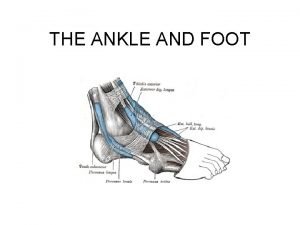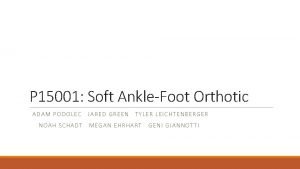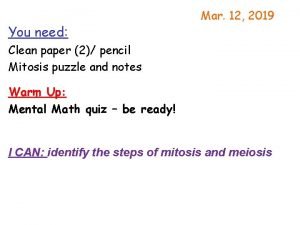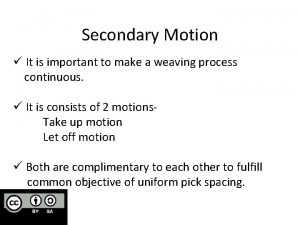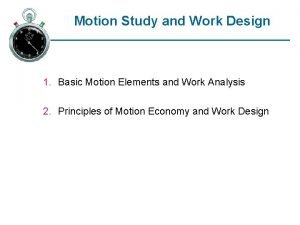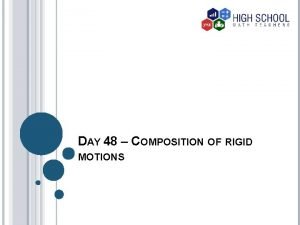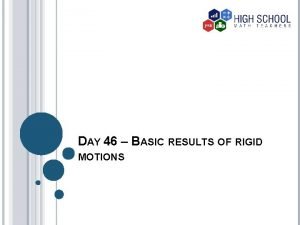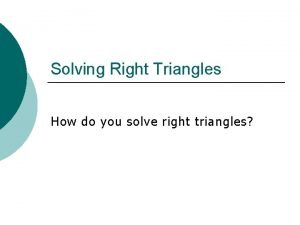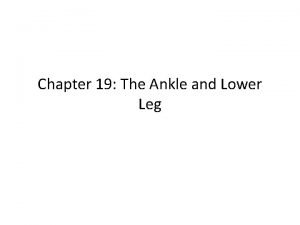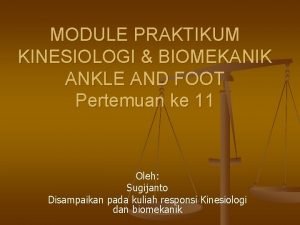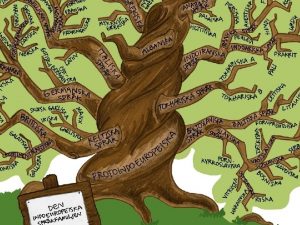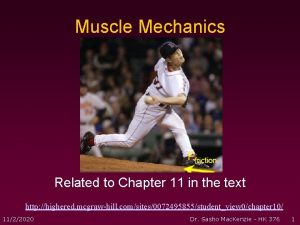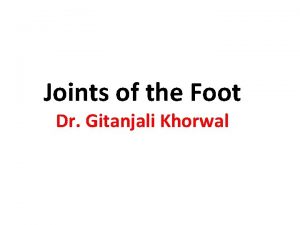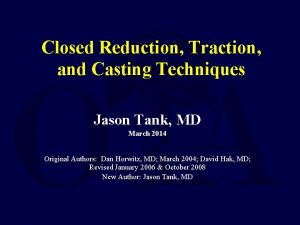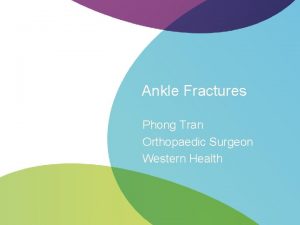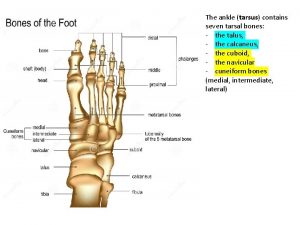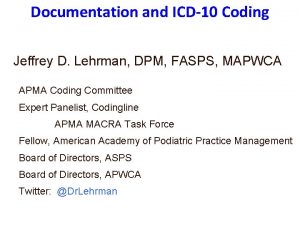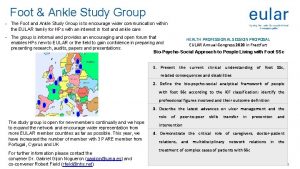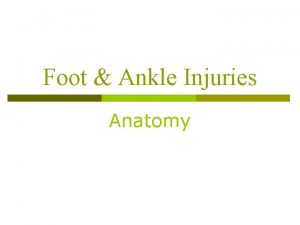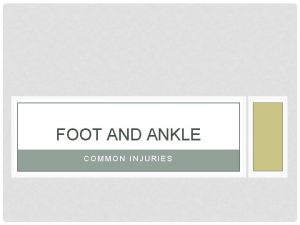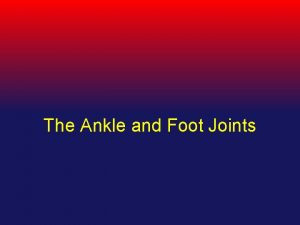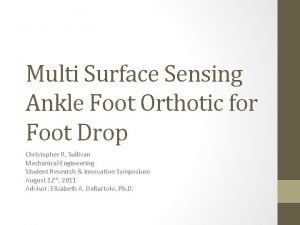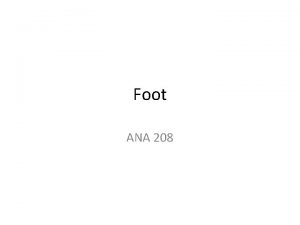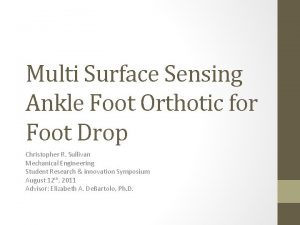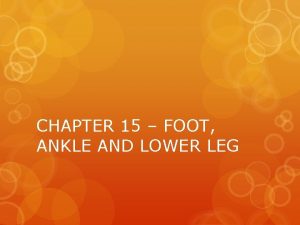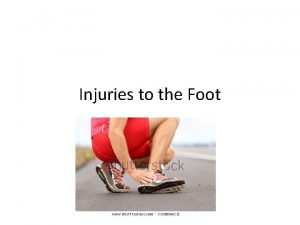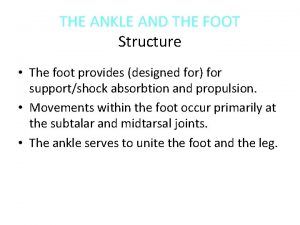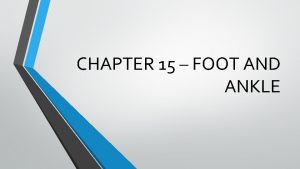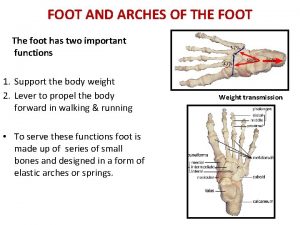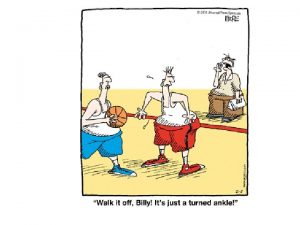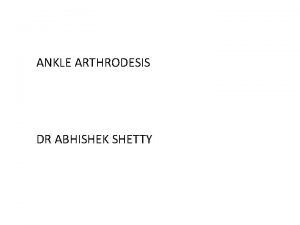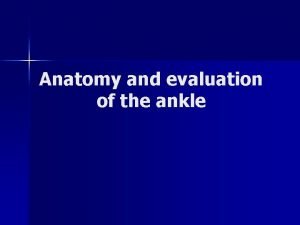FOOT ANKLE 4 Motions of the Foot Plantarflexion



























- Slides: 27

FOOT & ANKLE

4 Motions of the Foot Plantarflexion Dorsiflexion Inversion Eversion

Joints of the ankle Talocrual n n Plantarflexion Dorsiflexion

Joints of the ankle Subtalar – between talus & calcaneus n n Inversion Eversion Talus Calcaneus

Most ankle sprains happen in PF because of anterior movement of talus because of no bony congruence If limited at one joint – have excessiveness in another

4 Arches of the Foot medial longitudinal – 1 st metatarsal head to the talus; most common n pronated – flattened (pes planus) n supinated - excessive (pes cavus) lateral longitudinal – base of 5 th metatarsal up to calcaneus anterior metatarsal – across metararsal heads; if falls, increases distance between calcaneus & metatarsal heads; which leads to plantar fasciitis transverse arch – over tarsal bones; medial to lateral (navicular to cuboid)


Why more inversion ankle sprains? Lateral malleolus is more distal than medial malleolus The deltoid complex is stronger than the ligaments on the lateral side

Lateral Complex Ligaments n n n Anterior talofibular ligaments (ATF) – talus to fibula; 1 st to be injured Calcaneal fibular ligament (CF) Posterior talofibular ligament (PTF) Ligamentous injuries ATF – plantar flexion; inversion CF – inversion, either dorsiflexion or neutral PTF – inversion, dorsiflexion


Medial Complex Ligament n Deltoid Anterior tibiotalar (ATT) Posterior tibiotalar (PTT) Tibionavicular (TN) Tibiocalcaneal (TC)


Other ligaments Anterior tibiofibular (ATF) n n internal rotation, plantar flexion (talus has to come out) High ankle sprain – long time to heal b/c can tape for DF, PF, INV, EV; but not rotation

Bifurcate n n attaches calcaneus & cuboid; sits on dorsum of foot Midfoot sprain – extreme forefoot varus in plantar flexed position

Spring (plantar calcanonavicular) n n n attaches to sustentaculum tali – “shelf” on calcaneous Chronic problem normally with gait problems; normally not injured in an acute injury

Muscles & Tendons Medial longitudinal arch n Flexor hallucis longus muscle starts on tibia & fibula runs posterior to malleolus under sustentaculum tali and in between sesmoids attaches to great toe; dynamic stabilizer of medial longitudinal arch n tibialis anterior starts as muscle and attached anterior to navicular n tibialis posterior long muscle; attaches into navicular

plantar fascia thick band of fascia covering the plantar aspect of the foot starts at medial calcaneal tubercle and attaches above MTP joint as toes go into extension; fascia (arch) increases wind last mechanism – “spring” to maintain normal alignment


Lower Leg Compartments Anterior n Muscles Tibialis anterior – dorsiflexion Extensor hallucis longus – extension of great toe Extensor digitorum longus – extension of toes Peroneus tertius – eversion n Nerve Deep peroneal nerve

Lateral n Muscles Peroneus brevis – eversion Peroneus longus – eversion n Nerve Superficial peroneal nerve Deep posterior n Muscles Flexor digitorum longus – flexion of toes Tibialis posterior – inversion, plantar flexion Flexor hallucis longus – flexion of great toe Popliteus n Nerve Tibial nerve

Superficial posterior n Muscle Gastrocnemius – plantarflexion Soleus – plantarflexion Plantaris – plantarflexion n Nerve Tibial nerve

Range of Motion

Dorsiflexion 0 -20 How you measure n n n SA: fibular head MA: 5 th MT Axis: below joint – calcaneus Muscles involved n n 1 st – Tibialis Anterior 2 nd – EHL & ED Nerve n Deep Peroneal

Plantarflexion 0 -45 How you measure n n n SA: fibular head MA: 5 th MT Axis: below joint – calcaneus Muscles involved n n 1 st – Gastroc/Soleus 2 nd – Tibialis Posterior Nerve n Tibial

Inversion 0 -15 How you measure n n Lie prone SA: bisect calf MA: bisect calcaneus Axis: @ subtalar joint Muscles involved n n 1 st – Tibialis Posterior 2 nd – Tibialis Anterior Nerve n Tibial & Deep Peroneal

Eversion 0 -10 How you measure n n Lie prone SA: bisect calf MA: bisect calcaneus Axis: @ subtalar joint Muscles involved n 1 st – Peroneus longus & peroneus brevis Nerve n Superficial Peroneal

Manual Muscle Test (MMT) 0 1 2 3 4 5 no mm contraction, no joint mov’t take out gravity, mov’t “fair”, no resistance against gravity “good”, some resistance “normal”
 What are plantar flexors
What are plantar flexors Ankle foot orthoses
Ankle foot orthoses Foot orthosis instant design
Foot orthosis instant design Anatomy and physiology of the foot
Anatomy and physiology of the foot Mitosis flip book pdf
Mitosis flip book pdf Song leader hand signals
Song leader hand signals Different method of size separation
Different method of size separation Secondary motion in weaving
Secondary motion in weaving Ocean motions
Ocean motions Which transformations map the strip pattern onto itself
Which transformations map the strip pattern onto itself Therblig
Therblig Points and motions mun
Points and motions mun True motions
True motions Composition of rigid motions example
Composition of rigid motions example Basic rigid motions
Basic rigid motions Mimigarciah
Mimigarciah Put your left foot in
Put your left foot in Solving right triangles
Solving right triangles Chapter 19 worksheet the ankle and lower leg
Chapter 19 worksheet the ankle and lower leg End feel pada ankle
End feel pada ankle Finska språkfamilj
Finska språkfamilj Ankle eversion
Ankle eversion Ankle anatomy
Ankle anatomy Arches of the foot
Arches of the foot Traction flexion
Traction flexion Phong tran surgeon
Phong tran surgeon Seven ankle bones
Seven ankle bones Jeffrey lehrman dpm
Jeffrey lehrman dpm
